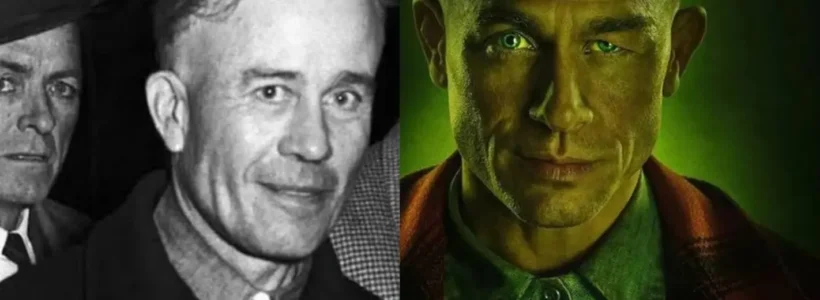The Netflix series Monsters: The Ed Gein Story has captivated true crime fans worldwide. Created by Ryan Murphy, this anthology series previously explored the cases of Jeffrey Dahmer and the Menendez brothers. Now, in its third season, it sheds light on one of America’s most terrifying criminals: Ed Gein.
But who was Ed Gein in real life? His gruesome crimes not only horrified the nation in the 1950s but also inspired some of the most legendary horror films of all time, including Psycho and The Texas Chainsaw Massacre.
A Troubled Childhood in the Heart of America
Born in 1906 in rural Wisconsin, Ed Gein grew up in an oppressive household under the control of his fanatically religious mother, Augusta. She preached that the world was sinful and that women were “tools of the devil.”
His father was an alcoholic and largely absent, leaving Augusta’s strict teachings to dominate Ed’s upbringing.
When Ed’s father and later his brother Henry died under mysterious circumstances, he was left alone with his mother. Her death in 1945 was a turning point. Isolated and consumed by obsession, Ed began reading books about cannibalism and atrocities — fantasies that would soon turn into real crimes.
Shocking Crimes That Horrified a Nation
Throughout the 1940s and 1950s, Ed Gein began robbing graves, collecting body parts to make horrifying household items.
When police raided his home, they discovered:
-
Human skin masks
-
A belt made of nipples
-
Furniture covered with human skin
-
Boxes of bones and preserved organs
Although he confessed to killing only two women — Mary Hogan and Bernice Worden — authorities suspected he may have been involved in other disappearances in the area. Gein also made a “skin suit,” believing it would allow him to transform into his deceased mother.
Arrest, Trial, and Psychiatric Confinement
Ed Gein was arrested in 1957 after Bernice Worden’s disappearance led police to his property. He was declared mentally incompetent and sent to a psychiatric hospital.
In 1968, he was retried and found guilty of murder, but again deemed legally insane. Gein spent the rest of his life confined in high-security mental institutions.
The Death of Ed Gein
Ed Gein died on July 26, 1984, at Mendota Mental Health Institute from respiratory failure due to lung cancer. He was 77 years old.
His gravestone was repeatedly vandalized and eventually stolen in 2000. It was later recovered, and his grave remains unmarked today.
The Fate of His House and Car
After his arrest, Gein’s house became a morbid curiosity site. Before it could be turned into a tourist attraction, it burned down mysteriously in 1958.
His car — the vehicle he used to transport bodies — was sold to a carnival owner, who charged visitors to see it at fairs.
Ed Gein’s Lasting Influence on Pop Culture
Ed Gein’s crimes have left a lasting mark on cinema and literature:
-
Psycho (1960) — Norman Bates’ obsession with his mother was inspired by Gein.
-
The Texas Chainsaw Massacre (1974) — Leatherface’s skin masks and bone-filled house mirror Gein’s home.
-
The Silence of the Lambs (1991) — Buffalo Bill’s “skin suit” is based on Gein’s horrific creations.
Even decades after his death, Ed Gein remains one of the most infamous figures in true crime history.
Ed Gein’s story is both horrifying and culturally significant. His crimes shocked 1950s America and shaped the horror genre for generations. With Netflix’s new series revisiting his case, interest in his macabre legacy is once again rising.

